World Nuclear News
Kairos Power fabricates and installs test unit reactor vessel
The central component for the second-iteration test unit for Kairos Power's Hermes reactor is the first reactor vessel to be fabricated in-house at Kairos Power’s Manufacturing Development Campus in Albuquerque, New Mexico.
_18684.jpg)
Kairos is following an iterative approach for the development of its Fluoride Salt-Cooled High-Temperature Reactor (KP-FHR) technology. The non-power Engineering Test Unit 2 (ETU 2.0) follows ETU 1.0, a full-scale, electrically heated prototype of the Hermes reactor which carried out more than 2000 hours of pumped salt operations demonstrating the design and integration of key systems, as well as exercising the supply chain and establish new capabilities, including the production of the high-purity fluoride-lithium-beryllium (FLiBe) salt coolant.
ETU 1.0 completed operations in mid-2024. ETU 2.0 will demonstrate modular construction methods: as part of the project the company is ramping up output of ASME U-stamped pressure vessels, producing specialised reactor components, and gaining proficiency in modular construction methods.
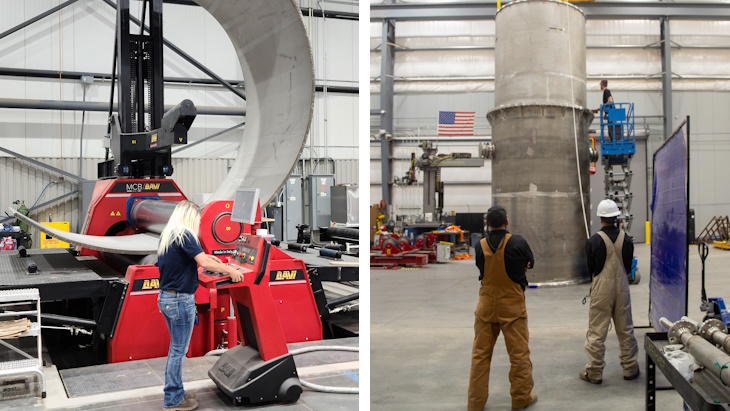
The dedicated shop for KP-FHR vessel production at Albuquerque includes large-scale plate-rolling, cutting, automated welding and machining capabilities. (Image: Kairos Power)
Kairos Power has established a dedicated shop in its Albuquerque facility for KP-FHR vessel production. Its in-house engineering, procurement, and manufacturing teams collaborated closely in the project to deliver the ETU 2.0 reactor vessel, enabling key learnings that will carry forward to future iterations, the company said. The company is minimising outsourced production of specialised components under its vertical integration strategy, aiming for 80% of ETU 2.0 costs to derive from raw materials or commercial off-the-shelf parts which it says gives better control over product cost, quality, and schedule.
Kairos Power co-founder and CEO Mike Laufer described the completion of the ETU 2.0 vessel as a "monumental achievement" for the company, illustrating the synergy between its rapid iterative development approach and vertical integration strategy. "We are systematically building the capabilities and know-how to self-produce major reactor components over multiple iterations - an investment that will ultimately lower costs for the commercial fleet," he said.
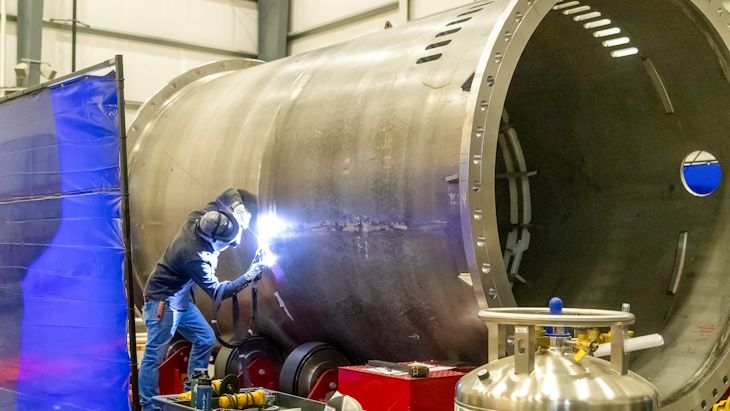
(Image: Kairos Power)
The KP-FHR is one of five technologies selected in 2020 to receive federal funding for risk reduction projects under the US Department of Energy's Advanced Reactor Demonstration Program, with the department investing up to USD303 million in the Hermes reactor project. The DOE ETU 2.0 reactor vessel is a contract milestone under that investment agreement.
ETU 2.0 will be followed by a third non-nuclear iteration, ETU 3.0, which will be built adjacent to the site in Oak Ridge, Tennessee, where the Hermes Low-Power Demonstration Reactor will be built. Both ETU 3.0 and Hermes will use reactor modules fabricated at the Albuquerque facility.
Hermes is the first non-light-water reactor to be permitted in the USA in over 50 years. It will not produce electricity, but Hermes 2 - a two 35 MWt-unit plant for which the US Nuclear Regulatory Commission issued a construction permit in November - will include a power generation system.
A deal signed in October by Kairos and Google will support the first commercial deployment of Kairos Power's reactor by 2030, with multiple reactors supplying clean electricity to Google data centres through power purchase agreements.
IAEA finds commitment to safety at Novovoronezh plant
The operator of Russia's Novovoronezh nuclear power plant has shown a commitment to enhancing operational safety, an International Atomic Energy Agency mission team has concluded.
_31757.jpg)
The aim of IAEA Operational Safety Review Team (OSART) missions is to assess safety performance against IAEA safety standards, highlight areas of good practice and propose improvements.
Requested by the Russian government, an OSART mission was conducted from 13 to 30 January. The team was composed of seven experts from Belarus, Brazil, China, Iran and South Africa, as well as four IAEA staff members and an observer from Russia. The team reviewed operating practices in units 4 and 6 of the Novovoronezh plant in the areas of leadership and management for safety, training and qualification, operations, maintenance, technical support, radiation protection, chemistry and accident management. An OSART mission was previously completed for unit 5 in 2015.
The Novovoronezh plant is located in the Voronezh region, about 600 kilometres south of Moscow. It is owned by state nuclear corporation Rosatom and operated by Novovoronezh NPP, a subsidiary of the Rosenergoatom Joint Stock Company. The plant consists of seven units. Units 1, 2 and 3 are permanently shut down and under decommissioning. Units 4, 5, 6 and 7 are operating. All units are pressurised water reactors (VVERs); units 4 and 5 are VVER-440 and VVER-1000, respectively. Units 6 and 7 are both VVER-1200.
Rosatom noted the OSART mission was unique in that, "for the first time, it was carried out at two Russian power units at once - unit 4 and unit 6 with reactors of different generations of VVER - 440 and 1200".
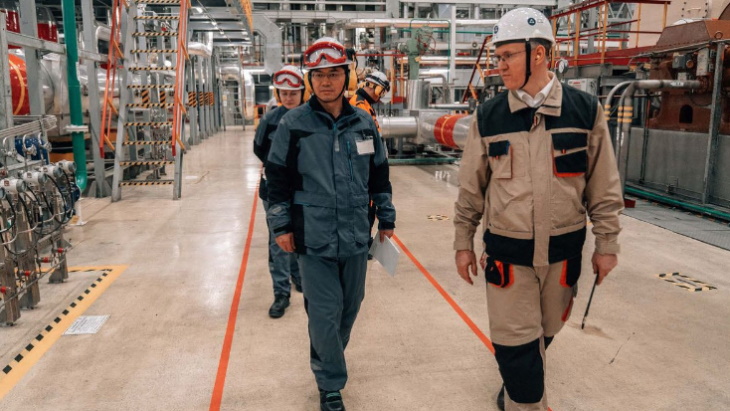
(Image: Rosatom)
"The OSART team observed that the staff at the plant are knowledgeable and professional and are committed to improving the operational safety and reliability of the plant," the IAEA said.
The team identified one good practice to be shared with the nuclear industry globally: the main control room operators at the plant have access to an electronic display for real-time indication of hydrogen ignition risk inside the containment building in the case of a severe accident.
The mission also provided some suggestions to further improve safety, including that the plant should consider enhancing: the consistent use of tools to minimise human error; the quality of maintenance activities; and the arrangements for the monitoring and reporting of equipment condition and material deficiencies to ensure that any degradation is identified and reported.
"We are grateful to the international experts of the IAEA for conducting a comprehensive inspection at two power units of the Novovoronezh NPP – unit 4 and unit 6," said Novovoronezh Plant Director Vladimir Povarov. "This is a reputable team with over 282-years combined operational experience in the nuclear power industry.
"Three of the four Novovoronezh NPP power units in operation have already successfully undertaken an IAEA international peer review. And we plan for power unit 7 to be subjected to this procedure in the future."
A draft copy of the mission's report has been provided to the plant management, and following any factual comments provided, the final copy will be submitted to the Russian government within three months.
Indian budget launches Nuclear Energy Mission
Minister of Finance Nirmala Sitharaman promised federal funds for an initiative to develop at least five Indian-designed small modular reactors to be operational by 2033, as well as amendments to Indian legislation to encourage private sector participation, in the budget for 2025-2026.
_93545.jpg)
In her budget speech, Sitharaman announced the Nuclear Energy Mission for Viksit Bharat (Viksit Bharat is the government's strategy to make India into a completely developed nation by 2047).
"Development of at least 100 GW of nuclear energy by 2047 is essential for our energy transition efforts. For an active partnership with the private sector towards this goal, amendments to the Atomic Energy Act and the Civil Liability for Nuclear Damage Act will be taken up," Sitharaman said.
"A Nuclear Energy Mission for research & development of Small Modular Reactors (SMRs) with an outlay of INR20,000 crore will be set up. At least 5 indigenously developed SMRs will be operationalized by 2033."
INR20,000 crore is around USD2.5 billion (1 crore is 10 million).
This follows commitments in 2024's budget to partner with the private sector on the development of the Bharat Small Modular Reactor - a compact 220 MW pressurised heavy water reactor based on India's reactor technology.
The Atomic Energy Act of 1962 prohibits private control of nuclear power generation in India: only two government-owned enterprises - NPCIL and Bharatiya Nabhikiya Vidyut Nigam Limited (BHAVINI, set up to build and operate fast reactors) - are legally allowed to own and operate nuclear power plants in India. Amendments to the act made in 2016 allow public sector joint ventures, but private sector companies and foreign investments are not allowed to invest directly in nuclear power in India.
The Civil Liability for Nuclear Damage Act of 2010 places responsibility for any nuclear accident with the plant operator and limits total operator liability - but allows the operator to have legal recourse to the reactor supplier, with no limit on supplier liability. This has been a stumbling block for overseas nuclear power plant vendors.
According to a statement from India's Department of Atomic Energy, the legislative changes are expected to create a more conducive environment for investment and innovation in the nuclear sector. The mission aligns with India's commitment to achieving 100 GW of nuclear energy capacity by 2047, a milestone deemed essential for reducing carbon emissions and meeting future energy demands.
India is already working to expand its nuclear capacity from 8180 MW today to 22,480 MW by 2031-2032, including the construction and commissioning of ten units totalling 8,000 MW across Gujarat, Rajasthan, Tamil Nadu, Haryana, Karnataka, and Madhya Pradesh, the DAE said. Pre-project activities for a further ten reactors are under way, and in-principle approval has been given for the construction of up to six units in cooperation with the USA: a site at Kovvada, in Andhra Pradesh, was earmarked for the construction of six AP1000 pressurised water reactors as long ago as 2016, but contractual arrangements have yet to be finalised.
In early January, India's nuclear power operator NPCIL issued a Request for Proposals from 'visionary Indian industries' to finance and build a proposed fleet of 220 MW Bharat Small Reactors to help decarbonise Indian industry.
"Civil nuclear energy will ensure a significant contribution to the country's development in future," Prime Minister Narendra Modi said in his response to the budget, which he said includes "significant steps" towards reforms.
India's budget is presented on 1 February, ahead of the start of the financial year on 1 April. Last year, due to Lok Sabha elections, an interim budget was presented in February: the full budget for 2024-2025 was not presented until July.
Start-up work under way for Akkuyu pumping station
The start-up and testing phase of the on-shore pumping station for Turkey's Akkuyu nuclear power plant's first unit has begun.
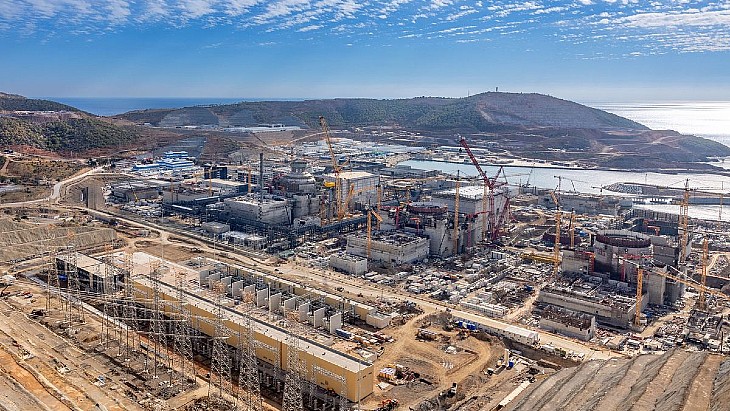
The pumping units for the main cooling water supply and pumps connected to the back-up diesel power supply are now undergoing load tests, with operating parameters of the equipment being checked, following test runs of the main cooling water pumping units.
The four-unit Akkuyu nuclear plant will be cooled by water from the Mediterranean Sea. There will be one pumping station for each power unit, a drainage channel, siphon wells, a distribution chamber, a water intake and spillway structure and desalination processes. Rosatom says the total capacity in the normal operation of the power unit will be 260,000 cubic metres per hour and that the design "will reliably protect the pumping station equipment from any external factors including floods and tsunamis".
Akkuyu Nuclear JSC CEO Sergei Butckikh said: "Construction and installation works at the pumping station are almost completed ... the nuclear power plant's largest pumps ... will provide water to all the cooling systems of the power unit, that is why stable operation of the pumps is extremely important for the reliable operation of the main equipment, including the reactor plant and the turbine unit. The onshore pumping station is a unique hydraulic engineering structure. The station’s design solution, developed taking into account the advanced safety standards, was successfully implemented thanks to the well-coordinated work of the Turkish-Russian team of designers and builders."
Background
Akkuyu, in the southern Mersin province, is Turkey's first nuclear power plant. Rosatom is building four VVER-1200 reactors, under a so-called BOO (build-own-operate) model. According to the terms of the 2010 Intergovernmental Agreement between the Russian Federation and the Republic of Turkey, the commissioning of the first power unit of the nuclear power plant must take place within seven years from receipt of all permits for the construction of the unit.
The licence for the construction of the first unit was issued in 2018, with construction work beginning that year. Nuclear fuel was delivered to the site in April 2023. Turkey's Nuclear Regulatory Agency issued permission for the first unit to be commissioned in December, and in February it was announced that the reactor compartment had been prepared for controlled assembly of the reactor - and the generator stator had also been installed in its pre-design position.
The aim is for unit 1 to begin supplying Turkey's energy system in 2025. When the 4800 MWe plant is completed, it is expected to meet about 10% of Turkey's electricity needs, with the aim that all four units will be operational by the end of 2028.
Blykalla starts work on non-nuclear prototype SMR
Swedish lead-cooled small modular reactor technology developer Blykalla had broken ground for the construction of an electrical small modular reactor pilot facility near Oskarshamn to test proof of concept of its SEALER technology.
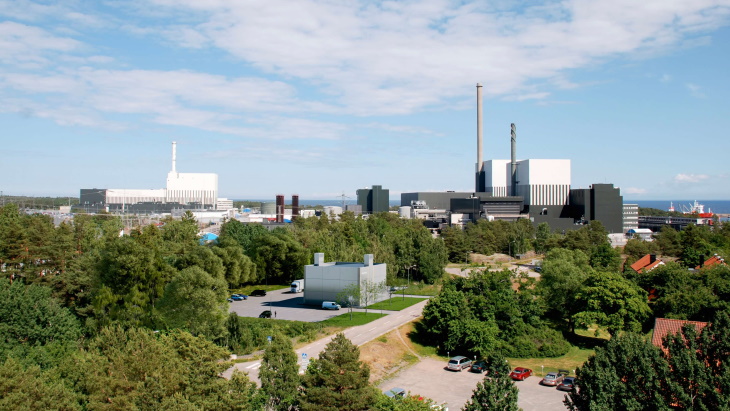
The groundbreaking ceremony was attended by Swedish Deputy Prime Minister and Minister of Energy Ebba Busch.
The Advanced Reactor Testing Site will house the electrical SEALER-E prototype reactor and aims to validate critical components and safety systems. The project is a collaborative effort including partners from Uniper, ABB, NCC and the Royal Institute of Technology (KTH). The Swedish Energy Agency has awarded a SEK99 million (USD9.3 million) grant for the project.
"This test facility is a significant step forward for Swedish nuclear innovation and a testament to the power of collaboration," said Blykalla CEO Jacob Stedman. "By uniting public and private partners, we are creating a foundation for the energy solutions the world urgently needs."
On 31 January, Blykalla announced it had selected NCC AB as the construction partner for the new test facility next to the Oskarshamn nuclear power plant. NCC will be responsible for the construction of the test facility, including site preparations and necessary installations.
The first phase of construction is expected to be completed by June with tests starting during the third quarter of 2025.
Blykalla - formerly called LeadCold - is a spin-off from the KTH, where lead-cooled reactor systems have been under development since 1996. The company - founded in 2013 as a joint stock company - is developing the SEALER.
A demonstration SEALER (SEALER-D) is planned to have a thermal output of 80 MW. As in future commercial reactors from Blykalla, the fuel rods will be cooled by 800 tonnes of liquid lead. The reactor will have a height and diameter of about 5 metres.
Blykalla's goal is for its first 140 MWt SEALER-55 commercial reactor to be ready for operation in the early 2030s.
No comments:
Post a Comment